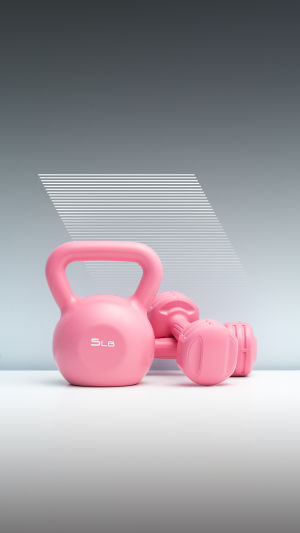Dumbbells are simple pieces of equipment used to strengthen muscles. Its main material is cast iron, and some are covered with a layer of rubber.
Its use is for muscle strength training and muscle compound action training.
Patients with low muscle strength due to motor paralysis, pain, and long-term inactivity can use dumbbells to perform active resistance exercises and train muscle strength. Increasing the weight of the dumbbell requires the coordination of multiple muscles, and it can also be used for compound action training.
In addition to iron dumbbells, wooden or plastic dumbbells can also be used. Practicing with wooden or plastic dumbbells can help cultivate the practitioner's coordination and sense of rhythm, and wooden dumbbells can even be woven into a complete set of gymnastics performances.
The kettlebell, also known as the stone lock, was created by the Russians 300 years ago. This type of cast iron bodybuilding equipment resembles a cannonball. Lifting kettlebells can improve muscle strength, muscle endurance, muscle explosiveness, and cardiorespiratory endurance. It is mainly used to enhance the body's muscle strength, endurance, balance, and flexibility.
Because dumbbells can be moved under and around their handles, kettlebells are more demanding on the entire body than training with dumbbells.
Lifting dumbbells can make a variety of movements, such as squatting, jumping, lifting and throwing, etc., which can greatly promote metabolism, burn calories, and build muscles, thus playing a positive role in reducing body fat and shaping. When practicing lifting dumbbells, you must pay attention to the accuracy of your movements, so that you can exercise more effectively.
One: Kettlebell swing
Hold the bell with one or both hands and swing it up with the strength of your hips in front of the body (without letting go of your hands), and then let the bell reach the back of your crotch naturally, do 3 sets with 30 left and right hands each. Add weight if you feel comfortable.
Note: As with any weight-bearing exercise, keeping the lower back straight and moderately tense can build endurance in the lower back, otherwise it can cause strain.
Two: lift the pot upwards
Hold the handles on both sides of the kettlebell with both hands, straighten your arms upwards to lift the kettlebell, pay attention to slow down the whole lifting process, and repeat 5 times.
Three: Kettlebell push-out method
Grasp the kettlebell handle with both hands, palms facing each other, bringing it close to your chest at shoulder height. Perform squats, sinking as low as you can. Straighten your arms, push the kettlebell straight in front of your body, retract the kettlebell to the shoulder position and stand up, repeat the training like this.
Four: Sit on the bench
Lie on a bench, bend your arms and hold the bell by your shoulders. Press the kettlebell up with both arms at the same time, then return to the ready position. Lie on a bench with arms bent and elbows held in front of your chest.
Swing your arms back above your head, with your fists down. Then return to the starting position from the original path. This action mainly develops the pectoralis major, arm muscles, and shoulder girdle muscles.





